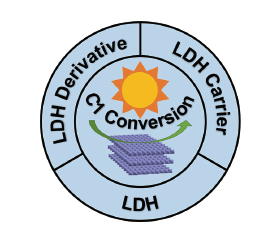 PDF(20263 KB)
PDF(20263 KB)


Nano-State Layered Double Hydroxides Based Materials for Photo-Driven C1 Chemical Conversion
Chi Duan, Zhenhua Li, Tierui Zhang
Prog Chem ›› 2023, Vol. 35 ›› Issue (6) : 940-953.
 PDF(20263 KB)
PDF(20263 KB)
 PDF(20263 KB)
PDF(20263 KB)
Nano-State Layered Double Hydroxides Based Materials for Photo-Driven C1 Chemical Conversion
Energy is the basic guarantee for human survival. As an important reaction in field of energy, C1 chemical conversion has safeguarded the development of human society. With the proposal of "double carbon" goal, energy saving-emission reduction and environmental friendliness have been the new pursuit of C1 catalytic conversion researchers. Recently, photo-driven C1 chemical conversion has attracted researchers’ attention through which C1 small molecules can be transformed into various value-added products under ambient condition. Layered double hydroxides (LDH) have gained wide application in photo-driven C1 chemical conversion for their distinctive two-dimensional layered structure. Herein, we review the latest progress achieved in nano-state LDH based materials for photo-driven C1 chemical conversion from three aspects containing LDH precursors acting as catalyst, LDH derivatives acting as catalyst and LDH acting as catalyst carrier, and conclude the challenges this field may face in the future. Through analyzing and discussing above-mentioned work, we hope to offer researchers some inspiration on photo-driven C1 chemistry.
1 Introduction
2 A brief introduction of LDH
2.1 Structural composition of LDH
2.2 Basic properties of LDH
3 Application of LDH based materials in photo-driven C1conversion
3.1 LDH precursors as catalyst
3.2 LDH derivatives as catalyst
3.3 LDH as catalyst carrier
4 Conclusion and outlook

C1 chemical conversion / LDH / photo-driven / valve-added chemicals
| [1] |
|
| [2] |
|
| [3] |
|
| [4] |
|
| [5] |
|
| [6] |
|
| [7] |
|
| [8] |
|
| [9] |
|
| [10] |
|
| [11] |
|
| [12] |
|
| [13] |
|
| [14] |
|
| [15] |
|
| [16] |
|
| [17] |
|
| [18] |
|
| [19] |
|
| [20] |
|
| [21] |
|
| [22] |
|
| [23] |
|
| [24] |
|
| [25] |
|
| [26] |
|
| [27] |
|
| [28] |
|
| [29] |
|
| [30] |
|
| [31] |
|
| [32] |
|
| [33] |
|
| [34] |
|
| [35] |
|
| [36] |
|
| [37] |
|
| [38] |
|
| [39] |
|
| [40] |
|
| [41] |
|
| [42] |
|
| [43] |
|
| [44] |
|
| [45] |
|
| [46] |
|
| [47] |
|
| [48] |
|
| [49] |
|
| [50] |
|
| [51] |
|
| [52] |
|
| [53] |
|
| [54] |
|
| [55] |
|
| [56] |
|
| [57] |
|
| [58] |
|
| [59] |
|
| [60] |
|
| [61] |
|
| [62] |
|
| [63] |
|
| [64] |
( 张辉, 储伟. 化学进展, 2009, 21(4): 622).
|
| [65] |
|
| [66] |
( 包信和. 科学通报, 2018, 63(14): 1266. ).
|
| [67] |
|
| [68] |
|
| [69] |
|
| [70] |
|
| [71] |
|
| [72] |
|
| [73] |
|
| [74] |
|
| [75] |
|
| [76] |
|
| [77] |
|
| [78] |
|
| [79] |
|
| [80] |
|
| [81] |
|
| [82] |
|
| [83] |
|
| [84] |
|
| [85] |
|
| [86] |
|
| [87] |
|
| [88] |
|
| [89] |
|
| [90] |
|
| [91] |
|
| [92] |
|
| [93] |
|
| [94] |
( 许珊, 王晓来, 赵睿. 化学进展, 2003, 15(2): 141).
|
| [95] |
|
| [96] |
|
| [97] |
|
| [98] |
|
| [99] |
|
| [100] |
|
| [101] |
|
| [102] |
|
| [103] |
( 林俊明, 岑洁, 李正甲, 杨林颜, 姚楠. 化工进展, 2022, 41(1): 201. ).
|
| [104] |
|
| [105] |
( 江文斌, 刘敬祥, 邱畅, 龙冉, 熊宇杰. 中国科学技术大学学报, 2020, 50(11): 1361.).
|
| [106] |
|
| [107] |
|
| [108] |
|
| [109] |
|
| [110] |
|
| [111] |
|
| [112] |
|
| [113] |
|
| [114] |
( 许振民, 卞振锋. 物理化学学报, 2020, 36(3): 1907013.).
|
| [115] |
|
| [116] |
|
| [117] |
|
| [118] |
|
| [119] |
|
| [120] |
|
| [121] |
|
| [122] |
|
| [123] |
|
| [124] |
|
| [125] |
|
| [126] |
|
| [127] |
|
| [128] |
|
| [129] |
|
| [130] |
|
/
| 〈 |
|
〉 |